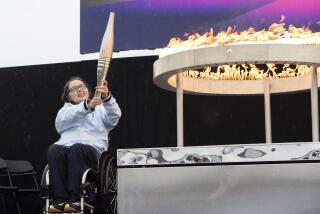It’s History in the Making
- Share via
ATHENS — They wore brilliant blues and vibrant greens and carried camcorders, small flags or hand-lettered signs. Athletes from large nations strolled in long, snaking rows, while those from tiny outposts walked in twos and threes -- or, in the case of Djibouti, a parade of one.
Some sported sensible shoes and natty blazers, while others chose pareos and bare feet. Heads were adorned with scarves, berets, tams and straw hats. Burundi’s delegation wore animal-print sarongs with sneakers.
Reveling in the similarities beneath their varied costumes, the world’s top athletes became a brilliant patchwork quilt of people Friday night as the Athens Summer Games opened with olive branches and wishes for harmony -- and security surveillance aircraft hovering above Olympic Stadium.
“Our world today is in need for peace,” Jacques Rogge, the president of the International Olympic Committee, told the 10,000 athletes from 202 nations standing before him. “Athens, I turn to you now.”
Gianna Angelopoulos-Daskalaki, president of the Athens 2004 organizing committee, promised a great show to the crowd of 70,000 and the world beyond. “You will be moved, you will be awed, inspired, exhilarated watching the best athletes of the world give their best, here in Athens,” she said. “Greece is going to fire the world’s imagination.”
Through flame and fireworks, allegorical sequences that surveyed Greek history and a procession of living statues that portrayed Greek art and artists from 2000 BC through 20th century opera diva Maria Callas, the nearly four-hour ceremony contained the requisite dose of pomp and circumstance. But it was preceded by a few whimsical moments, delighting a crowd that participated in the proceedings by waving tiny flashlights.
Poking fun at long delays that had jeopardized Athens’ ability to play host to its first Games since 1896, five hard-hatted construction workers unexpectedly emerged from a doorway and made a show of tacking down a final loose bit of carpet. One worker tore off his overalls to reveal street clothes and became the master of ceremonies of a warmup act, which was highlighted by a speeded-up video of the Olympic venues’ construction to the accompaniment of “Zorba the Greek.”
A water-filled performance area in the center of the stadium was the focal point of the main ceremony. The Olympic rings were set aflame atop the water and were extinguished by it; a young boy sailed from one end to the other in homage to Greece’s seafaring history and to symbolize youth and the future. He was met by Rogge, Angelopoulos-Daskalaki and the president of Greece, Constantinos Stephanopoulos.
The allegorical sequences, symbolizing the progress of Greek civilization and human consciousness, were set in and around the water. Actors portrayed the goddess Athena, the patron of Athens, as well as Aphrodite, Eros, Zeus and other mythical figures. The Hellenistic era of 480 BC to 30 BC was represented by Nike, the goddess of victory, and Alexander the Great; the Byzantine Era by St. George and the dragon. Fencers, discus throwers and runners evoked Greece’s modern era, from 1832 onward, by portraying participants in the 1896 Games.
The rolling panoply of history ended with an olive tree, considered sacred by Greeks, rising out of the water and into the sky. While the stage emerged to cover the water, the parade of nations began, with a deviation from its usual order.
Traditionally, Greece enters the stadium first and the host nation enters last. But because Greece is the host nation and an early entrance might have spoiled the evening’s drama, the Greek flag bearer, weightlifter Pyrros Dimas, entered the stadium alone.
He was followed by a long and colorful succession of athletes whose order was determined by the translation of their names from French (the IOC’s official language) to Greek. Some danced and waved to the crowd; others cradled cellphones as they moved in loose formation. Argentina’s athletes waved their light-blue scarves, the Japanese waved fans in pastel colors of pink, green and yellow, and one Australian held up a yellow sign with the message, “Hey Mum -- Kim.”
The U.S. contingent, which had been told by team leaders to ignore any anti-American sentiments from the crowd, was met enthusiastically. Allen Iverson, among the few elite NBA players participating in the Games, wore a red-white-and-blue U.S. beret and waved toward the stands. Tim Duncan, near the back of the pack, appeared to fuss over his camcorder before managing to record the event for posterity.
After the parade and a tribute to previous Summer Games sites, Angelopoulos-Daskalaki and Rogge greeted the throng in Greek, French and English. “Tonight history is being written,” Angelopoulos-Daskalaki said. “Tonight, with you and because of you.”
Said Rogge: “Athletes, through your conduct, give us reasons to believe in sport that is increasingly credible and pure, by refusing doping and respecting fair play.”
Stephanopoulos declared the Games open, touching off a chorus of bells and setting the stage for the raising of the Olympic flag. It hung motionlessly in the warm evening as Greek swimmer Zoe Dimoschaki and basketball referee Lazaros Voreadis took the oath on behalf of athletes and officials.
The illumination of the Olympic flame is usually the most dramatic moment, as it was Friday. Five torchbearers ran along the track before the flame was entrusted to Nikolaos Kaklamanakis, a 1996 windsurfing gold medalist. Climbing stairs that seemed to cascade from nowhere, he showed the torch to the crowd before touching the flame to the caldron, which will be its home until Aug. 29.
Said Angelopoulos-Daskalaki: “Olympic Games, welcome home.”
More to Read
Go beyond the scoreboard
Get the latest on L.A.'s teams in the daily Sports Report newsletter.
You may occasionally receive promotional content from the Los Angeles Times.







